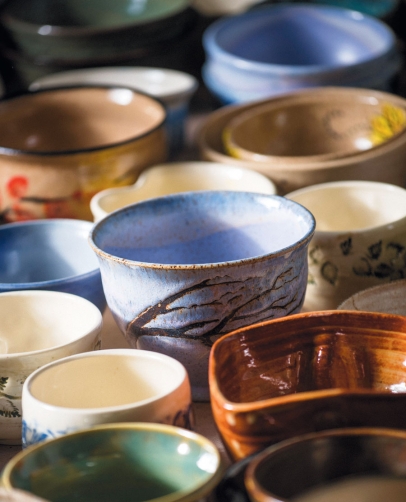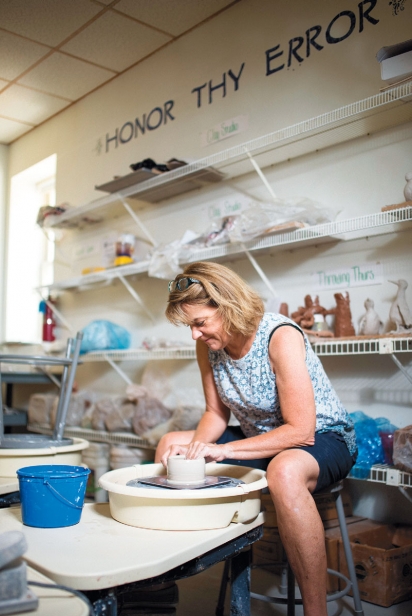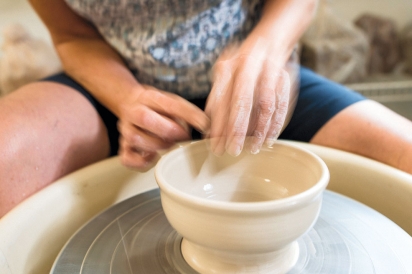Empty Bowls
Local Potters Get Behind the Wheel to Support the Hungry in Our Community
“If you’re a potter, the bowl is probably the simplest form there is,” says Jay Lacouture, a longtime professor of ceramics at Newport’s Salve Regina University. “The bowl is like an offering. It’s a very humble form, and everybody who’s ever been a potter at some point has made one. So it’s very humbling and simple—but at the same time it’s very complex in terms of what you’re able to do with it. It’s archetypal and universal. To me, that’s a nice way to approach drawing attention to the problem of hunger.”
What does pottery have to do with hunger?
In a recent conversation with Lacouture, we discussed the concept of Empty Bowls, an idea that started in a Michigan high school art classroom 26 years ago and has since snowballed into an international movement that brings together potters and hunger advocates.
Empty Bowls is a simple model: Ceramic artists donate their time and materials to create one-of-a-kind bowls, which are then given to those who attend a fundraiser as a reminder of those in their communities who may have trouble filling their own food bowls.
Last year, the Rhode Island Food Bank hosted its first Empty Bowls event to raise money to feed Rhode Islanders who are food insecure. This year, the event will take place on October 13 from 5:30 to 8:30 pm at Rhodes on the Pawtuxet. Guests of this casual, family-friendly evening will get to taste samples of soup, bread and dessert made and served by over 35 celebrated local chefs from around the state, as well as choose and keep one of the handmade bowls, which were made by more than 100 local potters.
Rhode Island Food Bank CEO Andrew Schiff explains further: “Empty Bowls is such a wonderful community event with contributions from local artists, restaurants and generous sponsors coming together to help end hunger in Rhode Island. And the impact goes well beyond the event. Last year nearly 1,000 guests helped raise $85,000 to support our neighbors in need of food assistance, proving that, if we all work together, we can ensure that no one goes hungry.”
Many artists, one bowl
To get a backstage peek at the artist community effort that goes into Empty Bowls, I visit Charlene Carpenzano’s ceramics class at the Newport Art Museum one bright Thursday morning. The popular class has been held for the past 14 years. The moment I step into the clay room, with its motto “Honor thy Error” painted large on the back wall, I can feel the positive energy radiating from each wheel and workstation.
“We love the idea of making vessels—and what a beautiful marriage it is between us and helping other people,” Carpenzano says, her hands deep in wet clay. “A handcrafted piece has a history behind it that a machine-made one does not. The throwing lines tell the story of where a person’s hands have been on it. The potter’s soul becomes part of that piece, and you can feel it when you pick it up.”
Carpenzano tells me how this group has become much more of a circle of friends than an art class, and how thrilled they are to participate in Empty Bowls each year. In June, 17 of her past and present students got together for an all-day “throw-a-thon” at the museum, where from 9 am to 3:30 pm they worked together to produce 83 unique bowls for September’s event.
Rather than creating bowls for the event individually, the artists collaborate on each piece. Carpenzano explains, “A bowl isn’t made by just one person—somebody threw it, somebody else trimmed it, somebody glazed it, somebody else helped me wrap and package them. So it’s really about a community and for everybody to participate in that one piece, and then for us to give them to other people in the wider community.”
Sue Ohama of Newport, one of Carpenzano’s longtime students and contributors to the project, tells me how she attended another Empty Bowls event in Jamestown. “As a potter, she says, “it’s a great way for us to do something we enjoy and give back to the community. I like the idea that it’s not only one person’s bowl—each one carries in it a little bit of all of us.”
Form, function and fun
“There should be more collaborations between potters and chefs,” says Lacouture. “I love to cook myself. It’s about the same kind of consciousness.”
It turns out that Lacouture isn’t alone. Nearly every potter I spoke to enjoys making the food and drink to fill their vessels, as much as creating the vessels themselves.
Carpenzano tells me that her class explores both functional (for eating and drinking) and nonfunctional (sculptural) ceramic forms. When creating functional pieces, they have many things to consider: how well the glaze will wash, whether it will fit in a dishwasher (“we want it to fit on that top rack!”), how the rim is constructed so as not to spill the last bit of soup, and ensuring the foot is wide enough so the piece won’t wobble.
“Form and function have to fit. And I think for us, it’s about form, function and fun,” she says.
Suzie Andrews, a cook, gardener and novice potter from Jamestown, then chimes in: “Sometimes it’s form, function and frustration!”
“As a cook, you work with the dish,” continues Andrews. “And when you plate it, you actually plate according to the dish and use it as part of your presentation. It enhances the food and the food enhances the pottery.”
“Potters are basically generous people who like to feed people,” says Lacouture.
When I ask him why people should consider coming out to Rhodes on the Pawtuxet this September, he answers, “Because there are people who are less fortunate right in our local community. The bowl is symbolic, that’s the beauty of the whole thing. Because most of us are pretty fortunate; our bowls are overfull.”
Empty Bowls will be held at Rhodes on the Pawtuxet in Cranston on Thursday, October 18, 2018 from 5:30 to 8:30 pm. Tickets must be purchased in advance.
For more information, visit RIFoodBank.org or call 401.942.6325.







